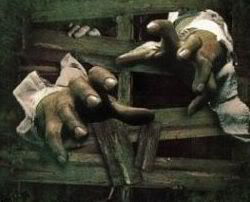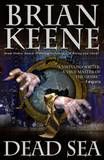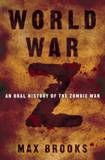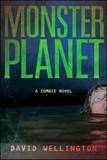The Literary Renaissance of the Zombie

By, Chad Helder
The evolution of any iconic monster from the horror genre usually goes something like this: shadowy origins deeply-rooted in European folklore, a variety of literary appearances over the last few centuries (with at least a couple of Victorian novels), followed by numerous film appearances dating from the 1930’s onward, which then ultimately leads to a pop-culture explosion including everything from video games to breakfast cereals. However, the zombie genre breaks this typical pattern.
The modern horror genre finds roots in a variety of folktale traditions. For example, the vampire and the werewolf both began in folklore, and even the proverbial “slasher” resembles the stories found in late 20 th century urban legends. Unlike the ever-ubiquitous vampire, which sprouted from folklore traditions and mutated into numerous literary and filmic incarnations, the modern zombie genre finds its true origin in a single film, The Night of the Living Dead . From there, the zombie infested modern cinema with unlimited variations. But now something fascinating has happened: at the same time that the zombie pop-culture explosion encompasses comic books, video games, and big-budget movies, zombies  now have crossed the boundary from film into literature and created a brand-new zombie literary genre (pioneered by writers like Brian Keene, Max Brooks, and David Wellington), which adds up to a complete aberration from the normal pattern – this is exciting stuff. While zombie books proliferate in the publishing houses, new and innovative forms of zombie-lore are emerging through internet-based publishing like blogs, PODs, and online web-serials, well outside the mainstream world of publishing. Kind of fitting, considering how it all began with a low budget zombie flick well outside the mainstream world of filmmaking. In a way, it’s almost like zombies are making their way backwards into a kind of digital folktale. After all, what is self-publishing but a king of storytelling from the people, outside the industry mainstream.
now have crossed the boundary from film into literature and created a brand-new zombie literary genre (pioneered by writers like Brian Keene, Max Brooks, and David Wellington), which adds up to a complete aberration from the normal pattern – this is exciting stuff. While zombie books proliferate in the publishing houses, new and innovative forms of zombie-lore are emerging through internet-based publishing like blogs, PODs, and online web-serials, well outside the mainstream world of publishing. Kind of fitting, considering how it all began with a low budget zombie flick well outside the mainstream world of filmmaking. In a way, it’s almost like zombies are making their way backwards into a kind of digital folktale. After all, what is self-publishing but a king of storytelling from the people, outside the industry mainstream.
Kyle Bishop, in his essay entitled “Raising the Dead: Unearthing the Nonliterary Origins of Zombie Cinema,” makes a strong case for the birth of the zombie genre, not in folklore like the werewolf and the vampire, but in Romero’s Night of the Living Dead . Of course, there is the zombie folklore from voodoo culture (Bishop also provides ample background on this subject), as well as numerous “zombie” films from the 1930’s like White Zombie , but Night of the Living Dead truly gave birth to something original, something that numerous writers are now trying to duplicate in print (and follow in new directions). We’re talking about the overwhelming zombie horde that multiplies exponentially and spells the end of civilization, whether they can run or not. Kyle Bishop argues: “Most classic monsters – from ghosts to vampires to werewolves – have their origins in folklore, and the zombie is no exception. However, whereas those other creatures have cross-cultural mythologies, the zombie remains a purely American monster...In addition, creatures such as Dracula passed through a literary tradition on their way to the silver screen, but the zombie did not.” With this in mind, it is fascinating to see this new uprising of zombie literature appear in response to the cult following of zombie cinema.
While there is no question about the hunger of mainstream audiences for all kinds of zombie media, the question of why so many writers feel compelled to offer their own literary rendering of this cinematic phenomenon remains. Why in this new century has the zombie become so prominent? What does the zombie mean anyway? From my view, zombies represent a variety of societal anxieties that seem to have taken a foothold in the new century, and there is something about the relentless zombie horde that captures the imagination of writers as much as the passion of audiences.
To begin to answer the question of what the zombie horde means, I want to turn to a new literary voice with two zombie  masterpieces to his credit, Max Brooks, author of The Zombie Survival Guide , which might at first appear to be simply a postmodern parody, and World War Z: An Oral History of the Zombie War . In his brilliant World War Z , Brooks offers a global manifestation of apocalyptic
masterpieces to his credit, Max Brooks, author of The Zombie Survival Guide , which might at first appear to be simply a postmodern parody, and World War Z: An Oral History of the Zombie War . In his brilliant World War Z , Brooks offers a global manifestation of apocalyptic  anxiety. Whether you view this as symbolically representative of impending environmental catastrophe, the possibility of nuclear devastation, or a virus run amok, this is terrifying stuff. These two works deal with zombie anxiety on a local and a global scale.
anxiety. Whether you view this as symbolically representative of impending environmental catastrophe, the possibility of nuclear devastation, or a virus run amok, this is terrifying stuff. These two works deal with zombie anxiety on a local and a global scale.
Zombie anxiety itself has many levels. Having your own body bitten, eaten, and taken over, as well as losing your own individual identity is horrifying enough, but this is compounded by seeing your loved ones taken over. Zombie stories are preoccupied with losing loved ones. On top of this, the breaking down of society and the ensuing chaos magnifies the nightmare. “Zombies, Mr. Brooks said, are the perfect goblin for such times, in part because they suggest broad social collapse, when anyone – a policeman, a nurse, a friend – can turn into a force of evil. With a werewolf or vampire, all the evil is concentrated on a single creature; with zombies, the evil is everywhere.” It’s easy to understand this apocalyptic anxiety with rampant terrorism and nuclear arms on the loose. Warren St. John writes in the New York Times , “It does not take much of a stretch to see the parallel between zombies and anonymous terrorists who seek to convert others within society to their deadly cause. The fear that anyone could be a suicide bomber of a hijacker parallels a common trope of zombie films, in which healthy people are zombified by contact with other zombies and become killers.” Zombies perfectly embody this anxiety through a nightmarish metaphor – this is how nightmares work after all, but zombies are more complex than they initially appear.
Nothing expresses anxiety about trouble in the homeland more than a zombie invasion, and this is what Max Brooks’ serio-comic Zombie Survival Guide demonstrates. From the dawning of Romero’s seminal Night of the Living Dead , the rules of how to defend yourself (the upstairs strategy versus the downstairs strategy) has become an integral part of the genre,  and Brooks’ handbook takes this to brilliant extremes – ultimately reminiscent of training manuals on how to survive a nuclear explosion. Guidelines and strategies for defending your immediate home (like the farmhouse in Night of the Living Dead ) – domestic defense against the undead – suggests the guidelines and strategies for building your bomb shelter from the previous era of the Cold War. Despite the satirical nature of Zombie Survival Guide , Brooks tells Rolling Stone , “I’m not being ironic… I was terrified of zombies as a kid. I think it’s their viral nature that makes them so scary. Fighting them is like trying to negotiate with AIDS.” He reiterates this viral theme in an interview with Publisher’s Weekly : “Zombies don’t act like a predator; they act like a virus, and that is the core of my terror. A predator is intelligent by nature, and knows not to overhunt its feeding ground. A virus will just continue to spread, infect and consume, no matter what happens. It’s the mindlessness behind it.” In the sense of mindlessly over-consuming, zombies act like a monstrous reflection of the human race, which could possibly be the most frightening connection of all.
and Brooks’ handbook takes this to brilliant extremes – ultimately reminiscent of training manuals on how to survive a nuclear explosion. Guidelines and strategies for defending your immediate home (like the farmhouse in Night of the Living Dead ) – domestic defense against the undead – suggests the guidelines and strategies for building your bomb shelter from the previous era of the Cold War. Despite the satirical nature of Zombie Survival Guide , Brooks tells Rolling Stone , “I’m not being ironic… I was terrified of zombies as a kid. I think it’s their viral nature that makes them so scary. Fighting them is like trying to negotiate with AIDS.” He reiterates this viral theme in an interview with Publisher’s Weekly : “Zombies don’t act like a predator; they act like a virus, and that is the core of my terror. A predator is intelligent by nature, and knows not to overhunt its feeding ground. A virus will just continue to spread, infect and consume, no matter what happens. It’s the mindlessness behind it.” In the sense of mindlessly over-consuming, zombies act like a monstrous reflection of the human race, which could possibly be the most frightening connection of all.
Underneath themes of post 9-11 anxiety and societal collapse, the zombie apocalypse story also shares the most primal themes with the horror genre: “Because anyone can potentially become a zombie, these films deal unabashedly with human taboos, murder, and cannibalism.” I think it is a combination of current societal anxieties in combination with the most elemental concerns of the horror genre that fuels the need for so many horror writers to attempt the genre.


 David Wellington’s horror project, a series of zombie novels blogged on his website, utilized the blog craze (helped along by RSS feeds and email lists) and resulted in publication of his zombie novels, Monster Island , Monster Nation , and Monster Planet , proving that cyber-writing and traditional publishing can co-exist together. And of course it helps to be writing about something as culturally relevant as zombies. Wellington expresses his theories on the popularity of the zombie: “the generic quality of zombies allows readers to project their particular fears onto them, and writers to personalize their zombies, which are otherwise blank slates. In some books, zombies can think or talk; in others they simply babble nonsense and are thoughtless.” The Zombie has a revolving meaning, depending on the context and the particular aims of the writer.
David Wellington’s horror project, a series of zombie novels blogged on his website, utilized the blog craze (helped along by RSS feeds and email lists) and resulted in publication of his zombie novels, Monster Island , Monster Nation , and Monster Planet , proving that cyber-writing and traditional publishing can co-exist together. And of course it helps to be writing about something as culturally relevant as zombies. Wellington expresses his theories on the popularity of the zombie: “the generic quality of zombies allows readers to project their particular fears onto them, and writers to personalize their zombies, which are otherwise blank slates. In some books, zombies can think or talk; in others they simply babble nonsense and are thoughtless.” The Zombie has a revolving meaning, depending on the context and the particular aims of the writer.
Like David Wellington, whose work bridges the gap from blog-serial to mainstream publication, a self-published zombie book entitled Day by Day Armageddon , originally a best-selling book on self-publishing house Lulu.com, has been picked up by Permuted Press.
These projects typify the growing popularity of the zombie genre with aspiring horror writers, a reflection on the genre’s timely cultural relevance and visceral, primal power (the common thread among all works of horror). Bishop argues that the absence of a zombie literary tradition (until now) implies that the zombie is primarily suited to the screen: “The zombie genre does not exist prior to the film age because of its essentially visual nature; zombies do not think or speak – they simply act, relying on purely physical manifestations of terror.” Even though film zombies do offer a powerful visual impact, the established writing careers of zombie masters Brian Keene and Max Brooks, as well as upcoming writers like David Wellington, prove that a new zombie literary genre is born and here to stay. The horror genre is perpetually fueled by a combination of film, literature, folklore, and other pop-culture storytelling (video games, comic books, etc.), and in the digital age where urban legends are transmitted through email messages and blogs, it is no wonder that many aspiring writers make an attempt at the difficult and fertile zombie genre through PODs and blogs, and this kind of web storytelling (just like the old-fashioned kind of folktales – ranging from the derivative to the innovative) ultimately becomes an integral part of the horror genre.
Bishop, Kyle "Raising the Dead: Unearthing the Nonliterary Origins of Zombie Cinema," Journal of Popular Film & Television 33.4 (2006): 196-205.
Bourne, J. L. Day by Day Armageddon (Lulu, 2005).
Brooks, Max. World War Z (New York: Crown, 2006).
Brooks, Max. The Zombie Survival Guide (New York: 3 Rivers, 2003).
Eaton, Lance. "Zombies Spreading like a Virus," Publisher's Weekly 2 Oct. 2006: 57.
Edwards, Gavin. "Max Brooks," Rolling Stone 19 Oct. 2006: 100.
Night of the Living Dead, dir. George Romero, Image Ten, 1968.
St. John, Warren. "Market for Zombies? It's Undead (Aaahhh!)," New York Times 26 Mar. 2006: 91.
Wellington, David. Monster Island (New York: Thunder's Mouth, 2006).
Wellington, David. Monster Nation (New York: Thunder's Mouth, 2006).
Wellington, David. Monster Planet (New York: Thunder's Mouth, 2007).
White Zombie, dir. Victor Halperin, perf. Bela Lugosi, Edward Halperin Prod., 1932




Reader Comments